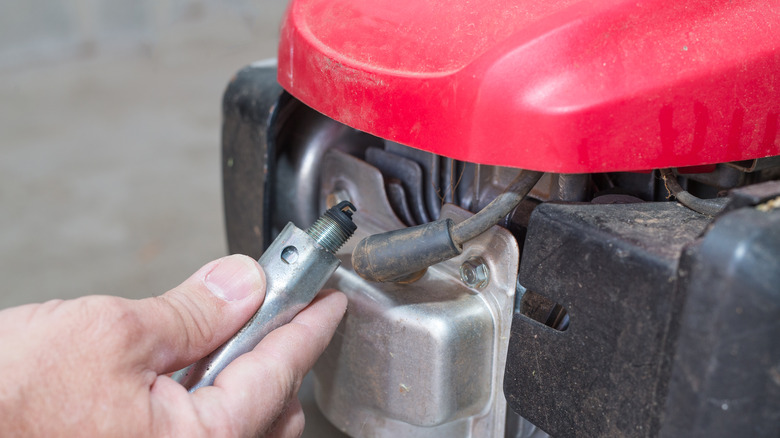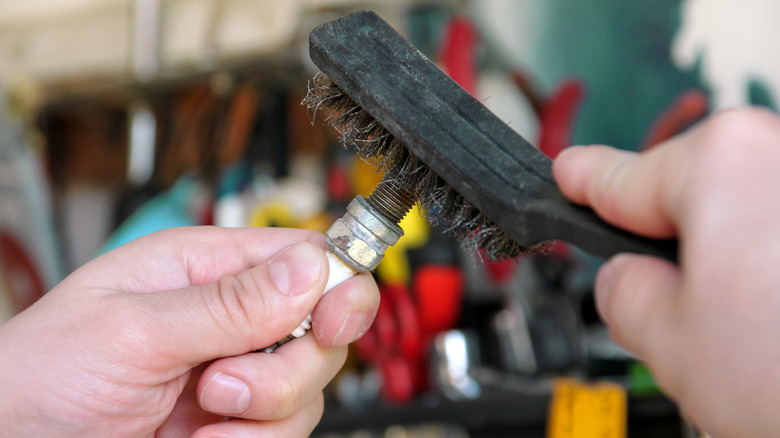When To Check The Spark Plug When Having Lawn Mower Issues
You may not be thinking about your lawn mower's functionality until you go to cut the grass, and it doesn't start. Or perhaps the mower does start, but it seems to run louder than normal, sputtering in and out as if it's about to stall. In these situations, the mower's spark plug may need to be replaced. While it's possible for a lawn mower to start, and even run, with a dirty or minimally functional spark plug, you should notice the difference in functionality. Using the mower doesn't feel smooth, and your arms may feel sore from the jerky movements of the machine as you cut the grass. If your lawn mower keeps dying before you can get the job done, checking the spark plug is the first step in getting back at it.
The combustion chamber in a lawn mower is where all the power is created. The spark plug's job is to create a spark and ignite the combustion chamber's fuel. If that spark isn't happening or isn't robust enough, the lawn mower isn't likely to get enough of the fuel it needs to move through your lawn with ease. It's not uncommon for spark plugs to need to be replaced or at least cleaned to keep them operating properly. If you're experiencing any type of lawn mower issue like the above and you haven't cleaned your spark plug recently, that's a good starting point for fixing your machine.
How to check your spark plug
So, you've noticed a few signs of problems — like the lawn mower's engine running but misfiring or stalling out after you get it running. You also may notice you're using more fuel than you used to, or you just can't start the lawn mower. When this happens, check the mower's spark plug. Your owner's manual will provide specific steps on how to locate the spark plug, which can be slightly different from one system to the next. Often, the device is located on the front of the mower, but it may also be located on the side of the engine.
Once located, you'll need to remove the spark plug to check it, which typically starts with wiping the surface surrounding the spark plug with a clean cloth to minimize debris infiltrating the chamber and then pulling the spark plug outward using a socket. Don't do this while the engine is hot, as you could burn yourself.
Once you have it out, look at the spark plug for cleanliness, as any type of buildup of debris could make it difficult for the device to operate properly. You may also notice portions of the head cracked or a charring that looks as if something has burned on the plug. If the spark plug is in good condition and doesn't have much buildup on it, however, that likely indicates it's not the culprit to your lawn mower issues. This said, it's still a good idea to clean the spark plug at this point before reinstalling it.
How to address a possible spark plug problem
To clean your lawn mower's spark plug of buildup, use a cloth to wipe away what you can. You can also use a wire brush or scouring pad to remove any debris that's really caked on. Your local automotive store will also carry spark-plug cleaners you can apply, or you can use brake cleaner to loosen the gunk. Simply spray the cleaner on, leave it for a few minutes, and then wipe it away with a cloth.
In other situations, though, cleaning isn't enough. Anytime there are obvious burned areas, or there's physical damage to the spark plug, you'll need to replace it with a new one. You may be able to purchase one from your automotive parts retailer or a lawn mower store. It's important to get exactly the same style to minimize any risk of damage to the lawn mower.
Finally, make it a plan going forward to clean your lawn mower's spark plug with regularity. You should have this done prior to the start of the grass-cutting season as a type of preventative maintenance. If you cut grass often, Briggs & Stratton recommends cleaning it after every 25 hours of lawn mower use. Once you learn how to do so, it only takes a few minutes to keep up with this step, and it could mean a smooth, easier grass-cutting session all season long.


